
¿Cuál sería el mejor lugar para construir un castillo de nieve?
Seasonal Weather Patterns
4.6
(2640 reviews)
Scroll for prep

Please wait…
This video is having trouble loading. You may have lost your Internet connection.
Step 1: Click to Reload this page
Step 2: Click to
Try our other video player
Step 3: Contact your teacher if trouble persists.
Or,
dismiss this message.
CONVERSEMOS:
¿Cómo sabes que es invierno en donde vives?
¿Qué cambios puedes ver?

Please wait…
This video is having trouble loading. You may have lost your Internet connection.
Step 1: Click to Reload this page
Step 2: Click to
Try our other video player
Step 3: Contact your teacher if trouble persists.
Or,
dismiss this message.

CONVERSEMOS:
¿Qué temperatura muestra este termómetro?
¿Hay OTRAS cosas que te indican si la temperatura es alta o baja?
¿Qué temperatura muestra este termómetro?
¿Hay OTRAS cosas que te indican si la temperatura es alta o baja?

Please wait…
This video is having trouble loading. You may have lost your Internet connection.
Step 1: Click to Reload this page
Step 2: Click to
Try our other video player
Step 3: Contact your teacher if trouble persists.
Or,
dismiss this message.

CONVERSEMOS: ¿Cómo crees que cambiará este lugar si la temperatura se mantiene A MÁS de 32 grados fahrenheit? ¿Qué cambios ocurrirán?

Please wait…
This video is having trouble loading. You may have lost your Internet connection.
Step 1: Click to Reload this page
Step 2: Click to
Try our other video player
Step 3: Contact your teacher if trouble persists.
Or,
dismiss this message.

CONVERSEMOS:
¿Habrá buen clima para construir castillos de nieve en donde vives este próximo invierno? ¿Cómo lo sabes?
¿Habrá buen clima para construir castillos de nieve en donde vives este próximo invierno? ¿Cómo lo sabes?

Please wait…
This video is having trouble loading. You may have lost your Internet connection.
Step 1: Click to Reload this page
Step 2: Click to
Try our other video player
Step 3: Contact your teacher if trouble persists.
Or,
dismiss this message.
CONVERSEMOS:
Supón que quieres encontrar un buen lugar para construir un castillo de nieve este próximo diciembre.
¿Qué tipos de datos tendrías que recolectar para poder encontrar un lugar que tenga el clima perfecto para construir castillos de nieve?

Please wait…
This video is having trouble loading. You may have lost your Internet connection.
Step 1: Click to Reload this page
Step 2: Click to
Try our other video player
Step 3: Contact your teacher if trouble persists.
Or,
dismiss this message.

Please wait…
This video is having trouble loading. You may have lost your Internet connection.
Step 1: Click to Reload this page
Step 2: Click to
Try our other video player
Step 3: Contact your teacher if trouble persists.
Or,
dismiss this message.
Paso
01/18
01/18
En esta actividad, trabajarás con otra persona. Cuando tengas un
compañero/a con quien trabajar, decidan quién será la bola de nieve
y quién será el hielito.
compañero/a con quien trabajar, decidan quién será la bola de nieve
y quién será el hielito.

Please wait…
This video is having trouble loading. You may have lost your Internet connection.
Step 1: Click to Reload this page
Step 2: Click to
Try our other video player
Step 3: Contact your teacher if trouble persists.
Or,
dismiss this message.
Paso
02/18
02/18
Escucharán información sobre las 3 ciudades que quieren tener
un festival. Pero primero, obtengan sus materiales.
un festival. Pero primero, obtengan sus materiales.

Please wait…
This video is having trouble loading. You may have lost your Internet connection.
Step 1: Click to Reload this page
Step 2: Click to
Try our other video player
Step 3: Contact your teacher if trouble persists.
Or,
dismiss this message.
Paso
03/18
03/18
Jackie te va a contar sobre Madison, Wisconsin. Observarás los
datos sobre esta ciudad. Hielito: En tu tabla de “¿Cómo es el
clima?” escribe "Madison, Wisconsin" en donde dice ciudad #1.
datos sobre esta ciudad. Hielito: En tu tabla de “¿Cómo es el
clima?” escribe "Madison, Wisconsin" en donde dice ciudad #1.

Please wait…
This video is having trouble loading. You may have lost your Internet connection.
Step 1: Click to Reload this page
Step 2: Click to
Try our other video player
Step 3: Contact your teacher if trouble persists.
Or,
dismiss this message.
Paso
04/18
04/18
Obtén la hoja de los termómetros. Fíjate en los termómetros de
Madison. Plática con tu compañero/a:
Madison. Plática con tu compañero/a:

Please wait…
This video is having trouble loading. You may have lost your Internet connection.
Step 1: Click to Reload this page
Step 2: Click to
Try our other video player
Step 3: Contact your teacher if trouble persists.
Or,
dismiss this message.
Paso
05/18
05/18
Bola de nieve: Encuentra todos los días que la temperatura
estuvo a MÁS de 32°F en Madison. Con un color rojo, tacha
cada día que fue demasiado caliente. Hielito: Cuenta el # de días.
estuvo a MÁS de 32°F en Madison. Con un color rojo, tacha
cada día que fue demasiado caliente. Hielito: Cuenta el # de días.

Please wait…
This video is having trouble loading. You may have lost your Internet connection.
Step 1: Click to Reload this page
Step 2: Click to
Try our other video player
Step 3: Contact your teacher if trouble persists.
Or,
dismiss this message.
Paso
06/18
06/18
Obtén tu Tabla del Clima. Hielito: Encuentra la hilera donde
escribiste Madison, Wisconsin. Escribe cuántos días demasiado
calurosos hubo en Madison.
escribiste Madison, Wisconsin. Escribe cuántos días demasiado
calurosos hubo en Madison.

Please wait…
This video is having trouble loading. You may have lost your Internet connection.
Step 1: Click to Reload this page
Step 2: Click to
Try our other video player
Step 3: Contact your teacher if trouble persists.
Or,
dismiss this message.
Paso
07/18
07/18
Bola de nieve: Encuentra los días en Madison que estuvieron
a MENOS de 25°F. Con un color azul, tacha cada día que fue
demasiado frío. Hielito: Escribe este número en la tabla.
a MENOS de 25°F. Con un color azul, tacha cada día que fue
demasiado frío. Hielito: Escribe este número en la tabla.

Please wait…
This video is having trouble loading. You may have lost your Internet connection.
Step 1: Click to Reload this page
Step 2: Click to
Try our other video player
Step 3: Contact your teacher if trouble persists.
Or,
dismiss this message.
Paso
08/18
08/18
Cualquier día que no tiene una X sería un día perfecto Bola de
nieve: Encierralos en un círculo. Hielito: Cuenta el #
de días perfectos en Madison y escríbelo en la tabla.
nieve: Encierralos en un círculo. Hielito: Cuenta el #
de días perfectos en Madison y escríbelo en la tabla.

Please wait…
This video is having trouble loading. You may have lost your Internet connection.
Step 1: Click to Reload this page
Step 2: Click to
Try our other video player
Step 3: Contact your teacher if trouble persists.
Or,
dismiss this message.
Paso
09/18
09/18
Piensa sobre el clima en Madison. Conversemos:

Please wait…
This video is having trouble loading. You may have lost your Internet connection.
Step 1: Click to Reload this page
Step 2: Click to
Try our other video player
Step 3: Contact your teacher if trouble persists.
Or,
dismiss this message.
Paso
10/18
10/18
Deniki te va a contar sobre su ciudad: Fairbanks, Alaska. Luego,
veras los datos sobre Fairbanks. Hielito: En la tabla del
clima, escribe "Fairbanks, Alaska" donde dice ciudad #2.
veras los datos sobre Fairbanks. Hielito: En la tabla del
clima, escribe "Fairbanks, Alaska" donde dice ciudad #2.

Please wait…
This video is having trouble loading. You may have lost your Internet connection.
Step 1: Click to Reload this page
Step 2: Click to
Try our other video player
Step 3: Contact your teacher if trouble persists.
Or,
dismiss this message.
Paso
11/18
11/18
Cambien de responsabilidades Bola de nieve : Marca los días
demasiado calurosos, demasiado fríos, y perfectos en Fairbanks.
Hielito: Escribe el # de cada tipo de día en la hilera para Fairbanks.
demasiado calurosos, demasiado fríos, y perfectos en Fairbanks.
Hielito: Escribe el # de cada tipo de día en la hilera para Fairbanks.

Please wait…
This video is having trouble loading. You may have lost your Internet connection.
Step 1: Click to Reload this page
Step 2: Click to
Try our other video player
Step 3: Contact your teacher if trouble persists.
Or,
dismiss this message.
Paso
12/18
12/18
Compara Madison con Fairbanks. Conversemos:

Please wait…
This video is having trouble loading. You may have lost your Internet connection.
Step 1: Click to Reload this page
Step 2: Click to
Try our other video player
Step 3: Contact your teacher if trouble persists.
Or,
dismiss this message.
Paso
13/18
13/18
José te va a contar sobre su ciudad: Truckee, California. Luego, verás
los datos sobre Truckee. Hielito: Escribe "Truckee, California"
en tu tabla del clima en donde dice ciudad #3.
los datos sobre Truckee. Hielito: Escribe "Truckee, California"
en tu tabla del clima en donde dice ciudad #3.

Please wait…
This video is having trouble loading. You may have lost your Internet connection.
Step 1: Click to Reload this page
Step 2: Click to
Try our other video player
Step 3: Contact your teacher if trouble persists.
Or,
dismiss this message.
Paso
14/18
14/18
Cambien de responsabilidades. Bola de nieve : Marca los días
demasiado calurosos, demasiado fríos, y perfectos en Truckee.
Hielito: Escribe el # de cada tipo de día en la hilera para Truckee.
demasiado calurosos, demasiado fríos, y perfectos en Truckee.
Hielito: Escribe el # de cada tipo de día en la hilera para Truckee.

Please wait…
This video is having trouble loading. You may have lost your Internet connection.
Step 1: Click to Reload this page
Step 2: Click to
Try our other video player
Step 3: Contact your teacher if trouble persists.
Or,
dismiss this message.
Paso
15/18
15/18
Compara Madison, Fairbanks, y Truckee. Conversemos:

Please wait…
This video is having trouble loading. You may have lost your Internet connection.
Step 1: Click to Reload this page
Step 2: Click to
Try our other video player
Step 3: Contact your teacher if trouble persists.
Or,
dismiss this message.
Paso
16/18
16/18
Hasta este punto, solo has visto la temperatura en estas ciudades.
Conversemos:
Conversemos:

Please wait…
This video is having trouble loading. You may have lost your Internet connection.
Step 1: Click to Reload this page
Step 2: Click to
Try our other video player
Step 3: Contact your teacher if trouble persists.
Or,
dismiss this message.
Paso
17/18
17/18
Hielito: escribe “tormentas de nieve” en donde dice “más datos.''
Bola de nieve: Cuenta el # de copos de nieve en cada ciudad.
Hielito: escribe el # de copos de nieve de cada ciudad en la tabla.
Bola de nieve: Cuenta el # de copos de nieve en cada ciudad.
Hielito: escribe el # de copos de nieve de cada ciudad en la tabla.

Please wait…
This video is having trouble loading. You may have lost your Internet connection.
Step 1: Click to Reload this page
Step 2: Click to
Try our other video player
Step 3: Contact your teacher if trouble persists.
Or,
dismiss this message.
Paso
18/18
18/18
Piensa en cómo las tormentas de nieve afectarían tu festival de
castillos de nieve. Conversemos:
castillos de nieve. Conversemos:

Please wait…
This video is having trouble loading. You may have lost your Internet connection.
Step 1: Click to Reload this page
Step 2: Click to
Try our other video player
Step 3: Contact your teacher if trouble persists.
Or,
dismiss this message.
CONVERSEMOS:
¿De qué sirve recolectar datos y hacer predicciones si sabemos que algunas estarán mal?

Please wait…
This video is having trouble loading. You may have lost your Internet connection.
Step 1: Click to Reload this page
Step 2: Click to
Try our other video player
Step 3: Contact your teacher if trouble persists.
Or,
dismiss this message.


estación
1 de 18
una parte del año que tiene un clima particular y que se repite cada año

verano
2 de 18
una de las cuatro estaciones del año, la temporada más calurosa en muchos lugares

invierno
3 de 18
una de las cuatro estaciones del año, la temporada más fría en muchos lugares

medir
4 de 18
describir algo usando números que después se pueden comparar
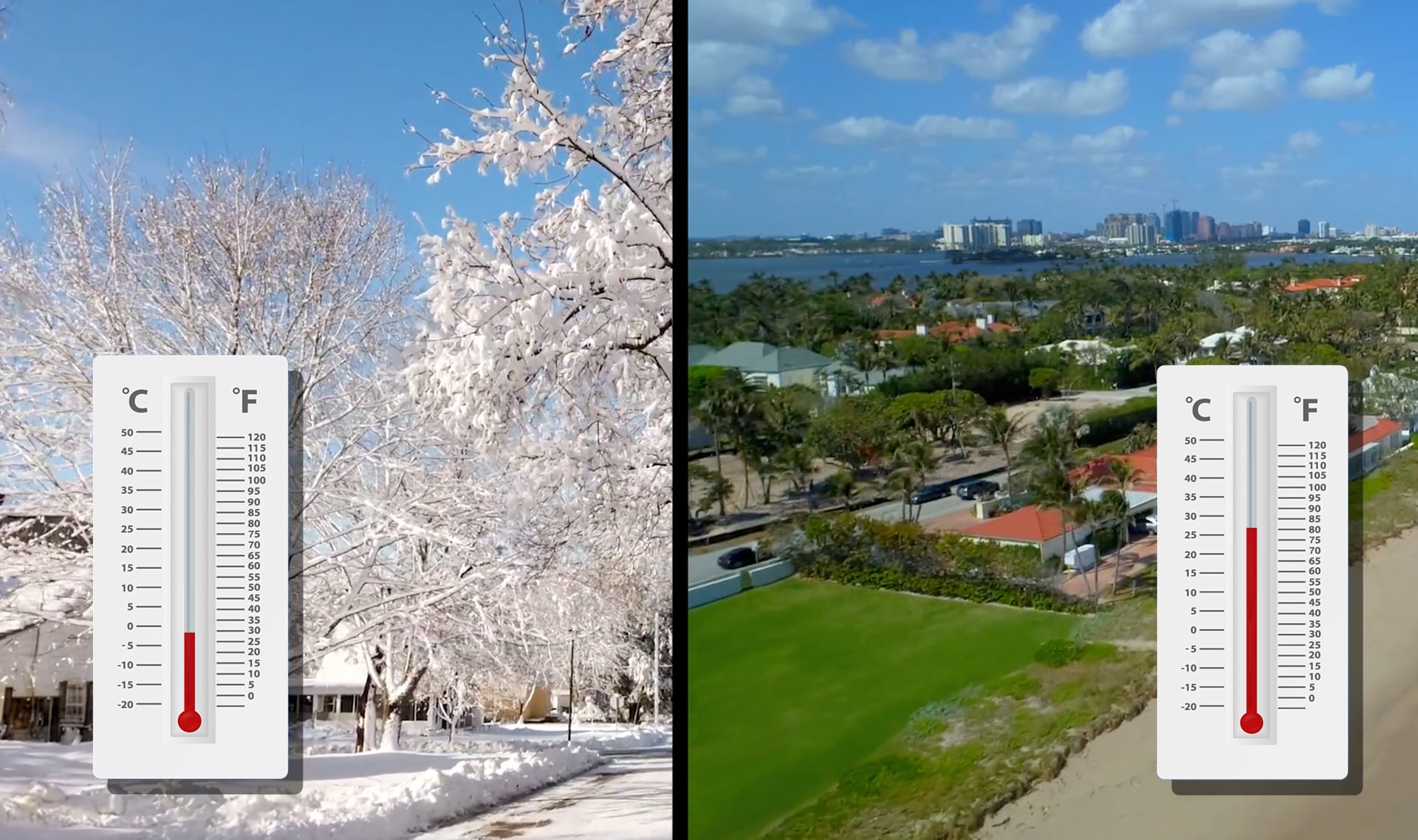
temperatura
5 de 18
lo caliente o frío que está algo

termómetro
6 de 18
una herramienta para medir la temperatura
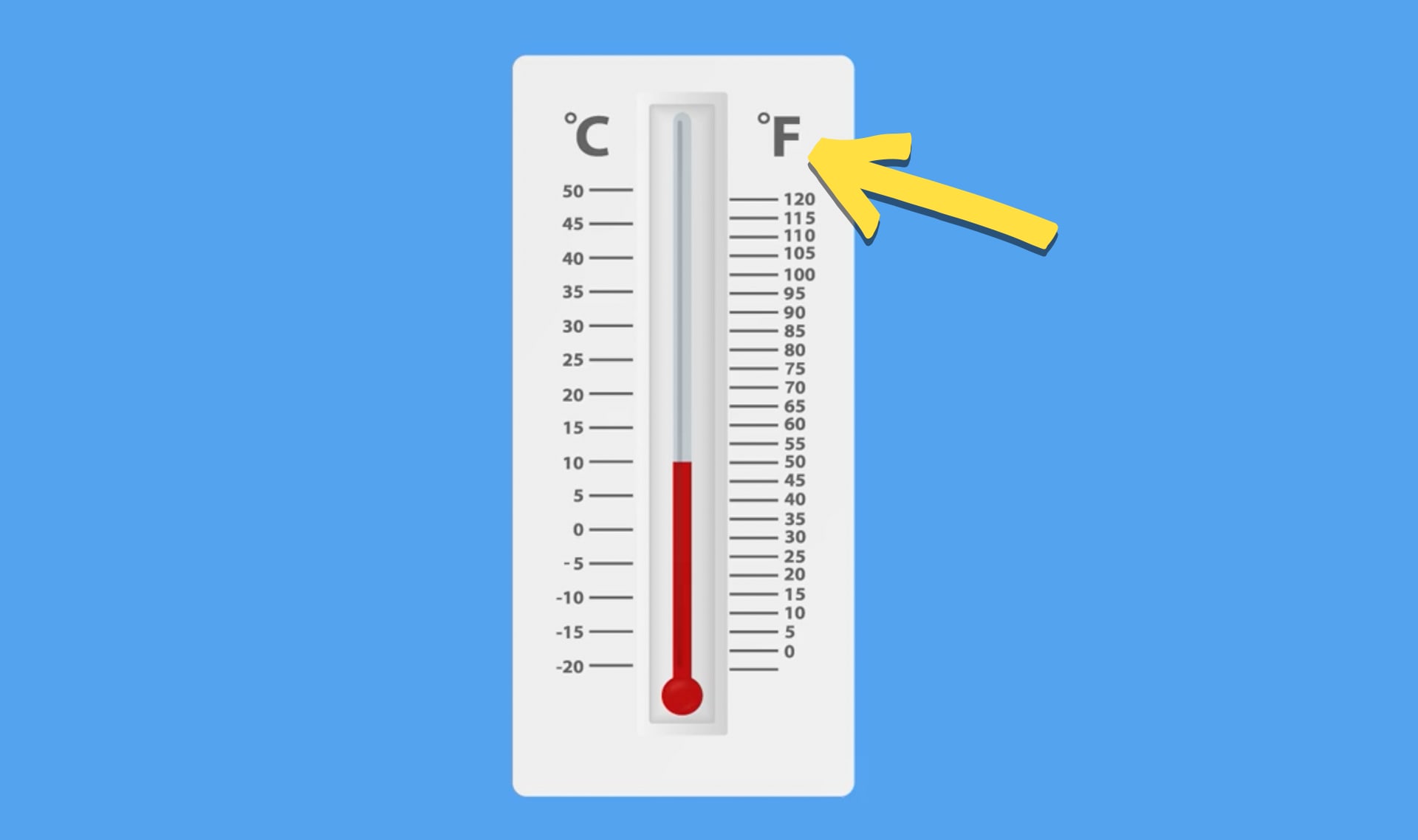
grados Fahrenheit
7 de 18
una manera de medir la temperatura; el agua se congela a 32 grados Fahrenheit
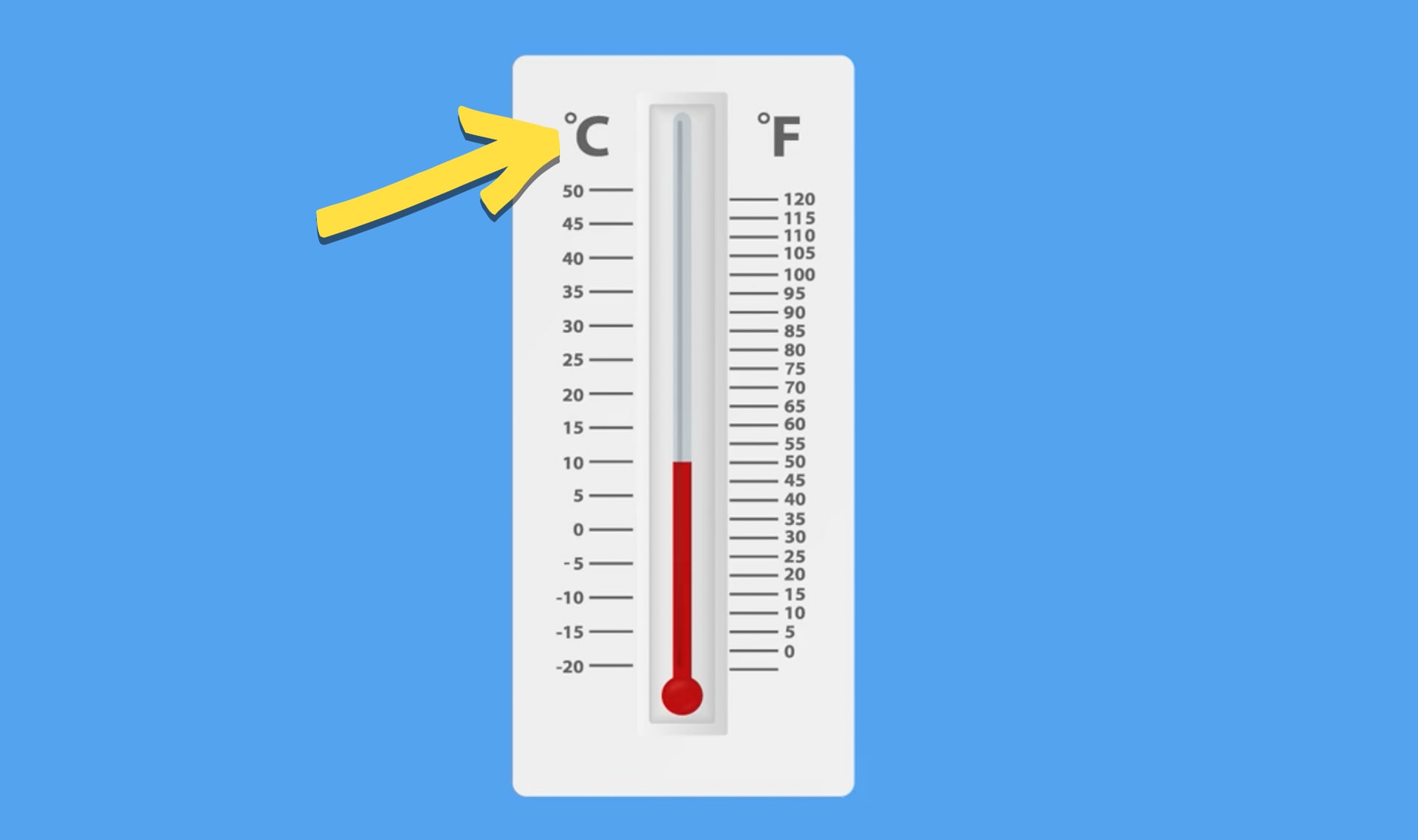
grados centígrados
8 de 18
una manera de medir la temperatura; el agua se congela a 0 grados centígrados
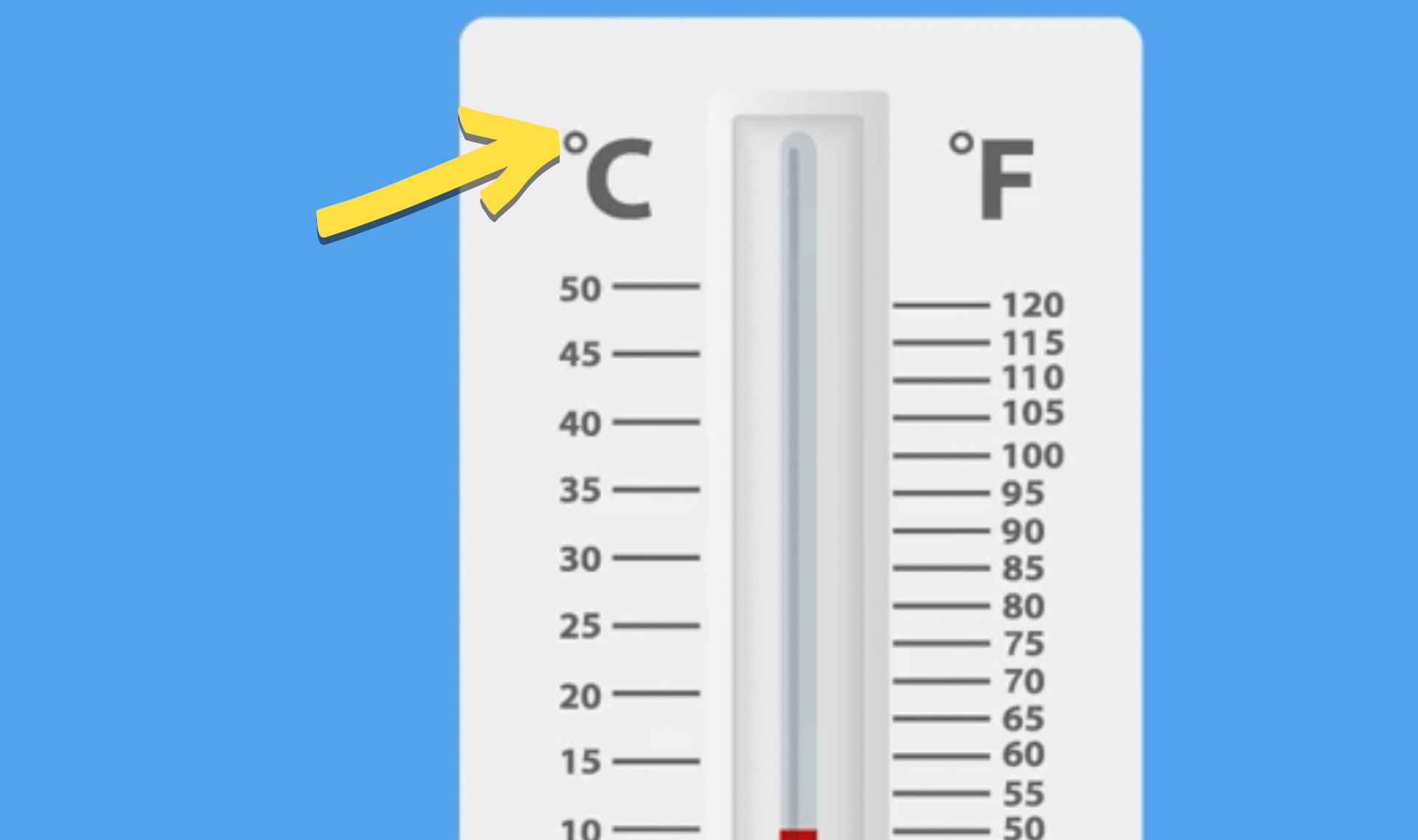
grado
9 de 18
unidad de medida que se usa para la temperatura

Please wait…
This video is having trouble loading. You may have lost your Internet connection.
Step 1: Click to Reload this page
Step 2: Click to
Try our other video player
Step 3: Contact your teacher if trouble persists.
Or,
dismiss this message.
congelación
10 de 18
cuando un líquido se convierte en un sólido, como cuando el agua líquida se convierte en hielo

Please wait…
This video is having trouble loading. You may have lost your Internet connection.
Step 1: Click to Reload this page
Step 2: Click to
Try our other video player
Step 3: Contact your teacher if trouble persists.
Or,
dismiss this message.
punto de congelación
11 de 18
la temperatura a la que el agua líquida se empieza a congelar y convertirse en hielo sólido
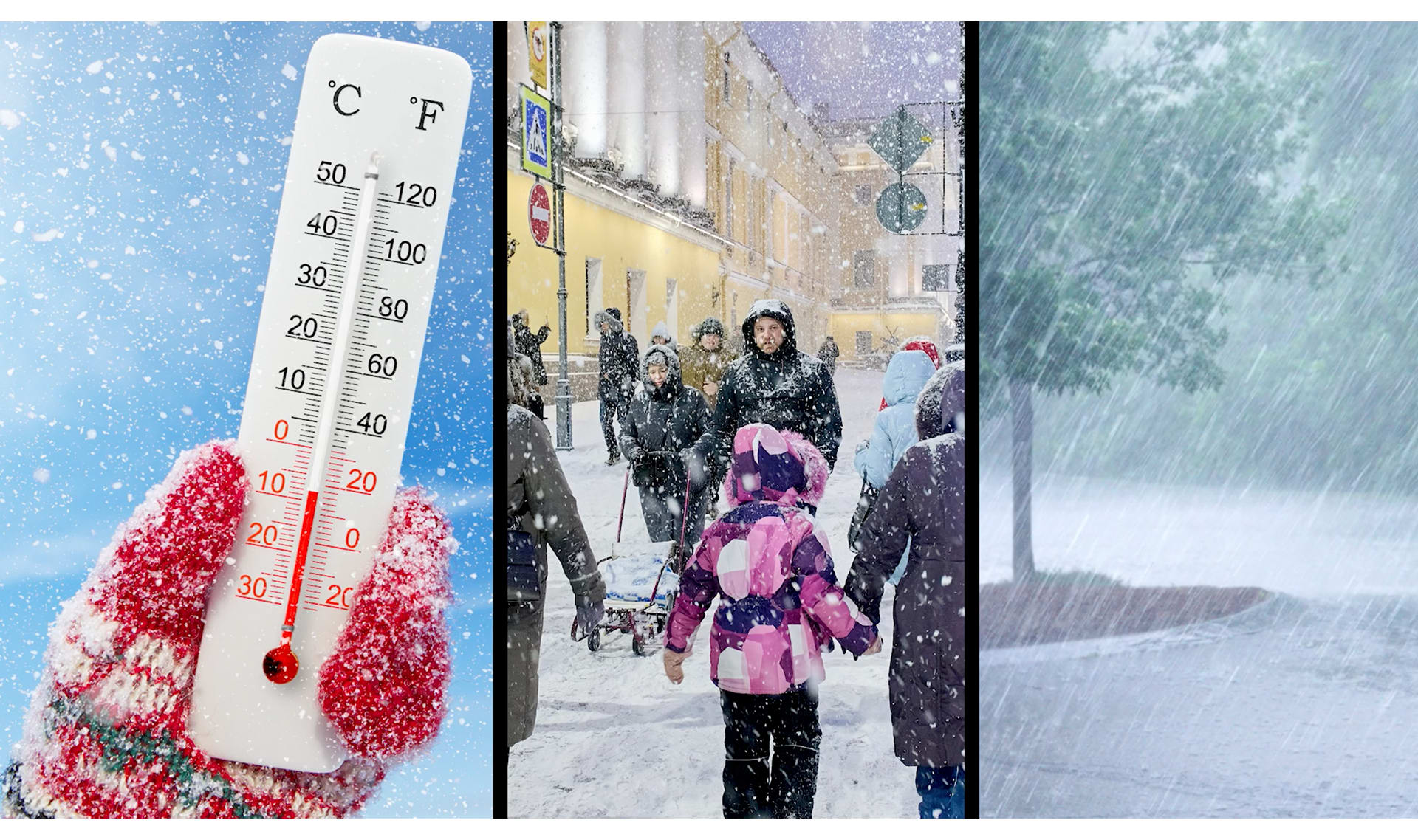
tiempo
12 de 18
el estado del aire en un momento y lugar determinado, incluye cosas como la temperatura, el viento y la lluvia

Please wait…
This video is having trouble loading. You may have lost your Internet connection.
Step 1: Click to Reload this page
Step 2: Click to
Try our other video player
Step 3: Contact your teacher if trouble persists.
Or,
dismiss this message.
tormenta
13 de 18
cuando hay mucho viento y lluvia o nieve

nieve
14 de 18
agua sólida que cae del cielo cuando hace mucho frío

Please wait…
This video is having trouble loading. You may have lost your Internet connection.
Step 1: Click to Reload this page
Step 2: Click to
Try our other video player
Step 3: Contact your teacher if trouble persists.
Or,
dismiss this message.
tormenta de nieve
15 de 18
una tormenta con mucha nieve y generalmente con vientos fuertes
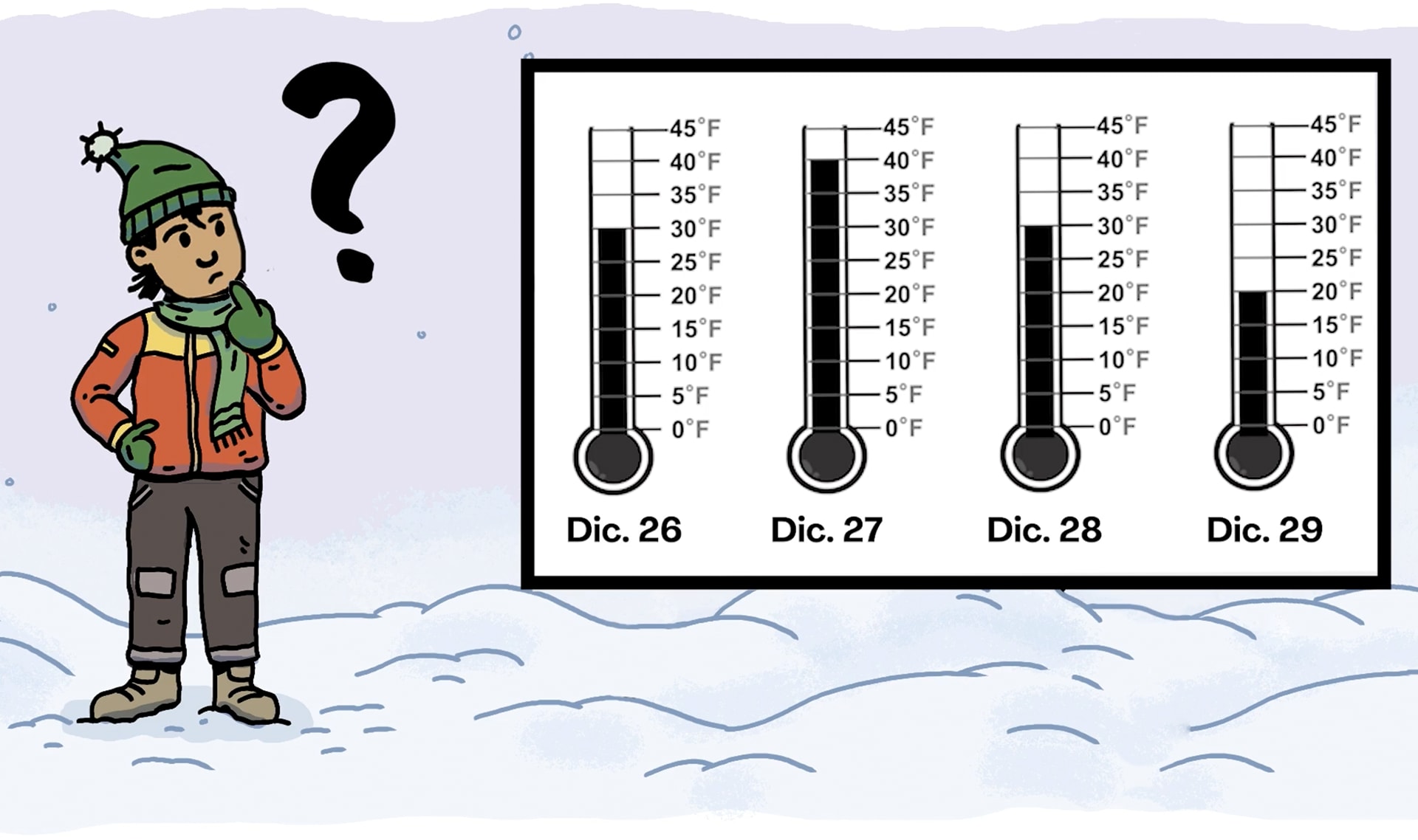
predecir
16 de 18
to guess what will happen based on things you know
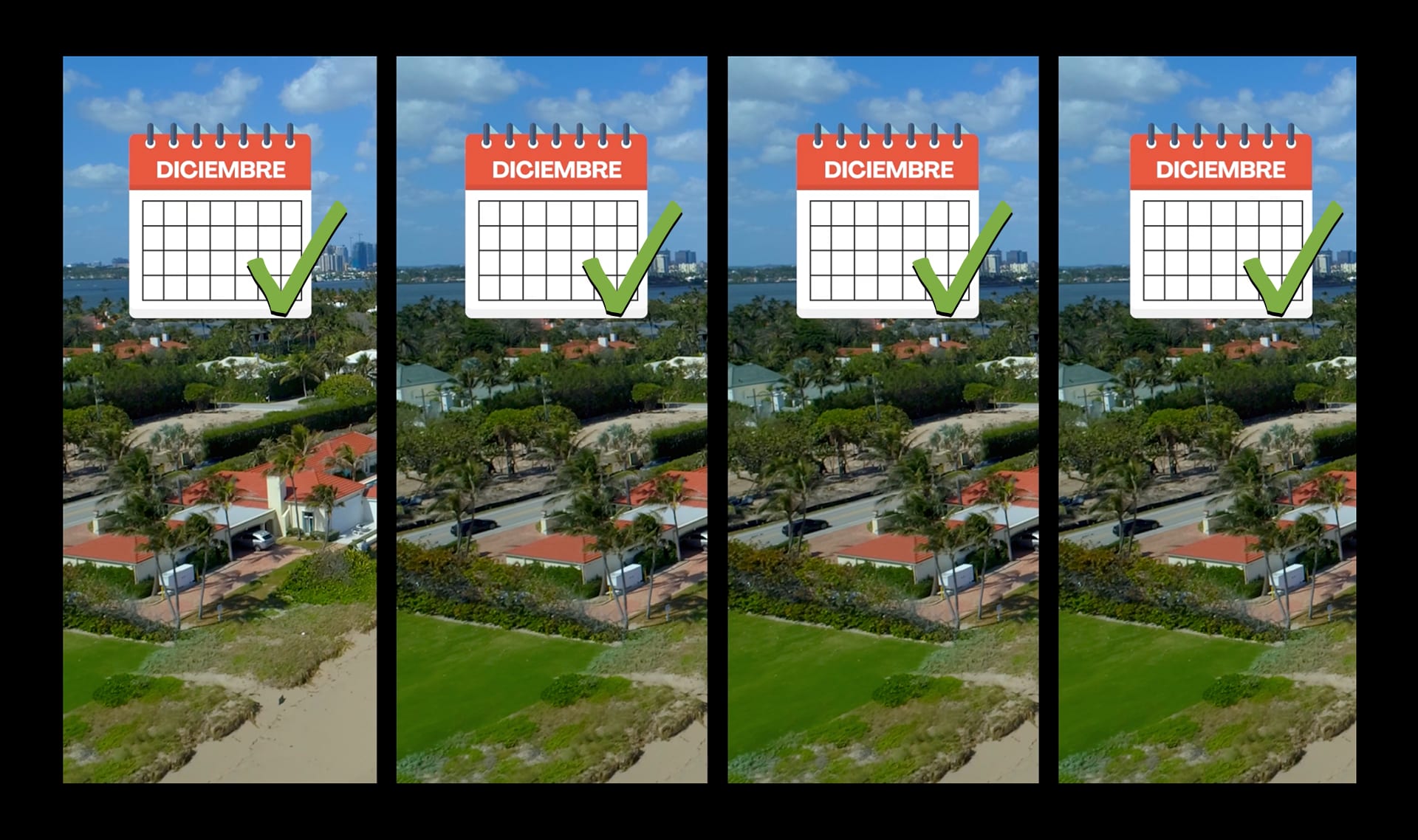
patrón
17 de 18
something that happens again and again and again in a way that can be predicted
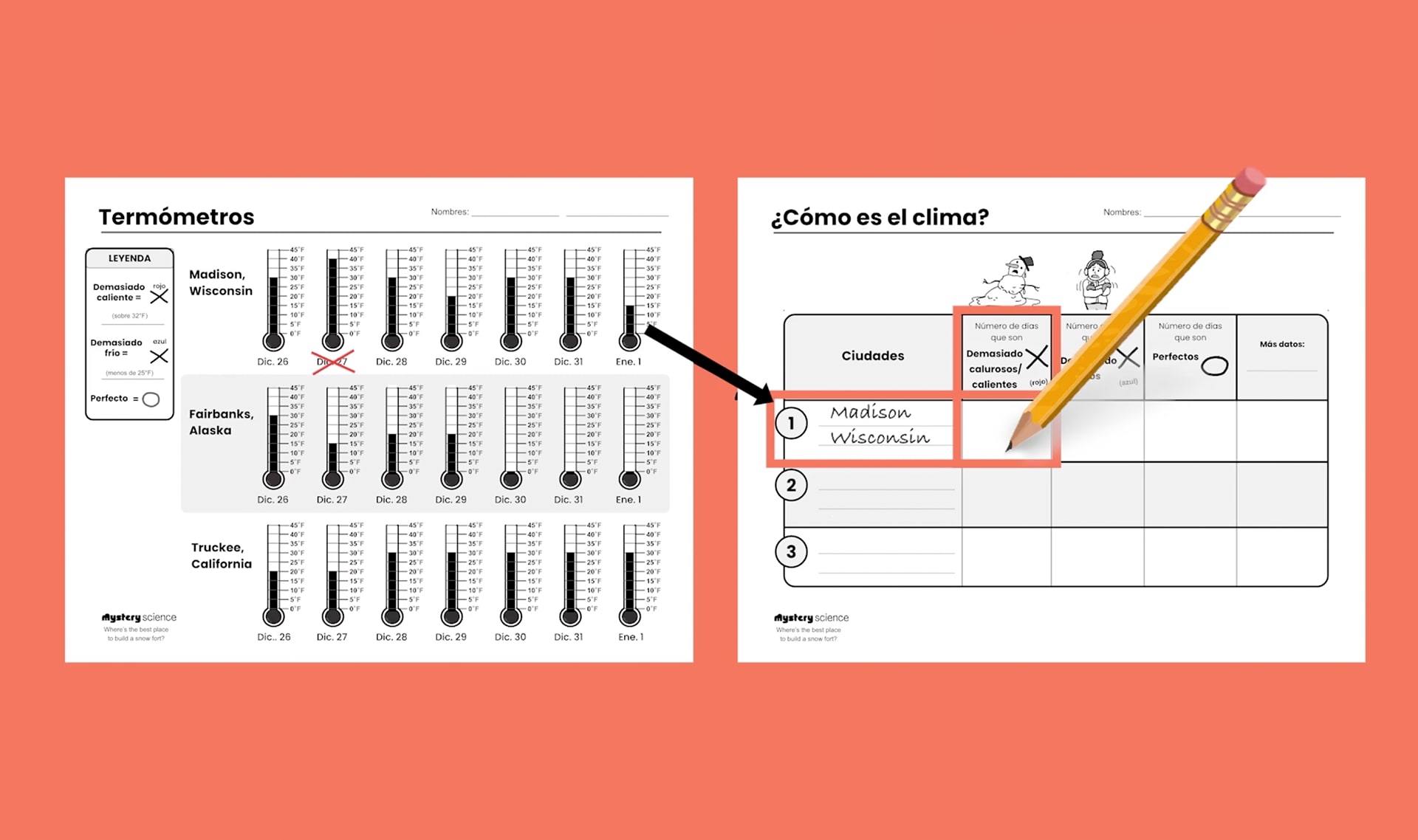
datos
18 de 18
medidas u observaciones que han sido anotadas


